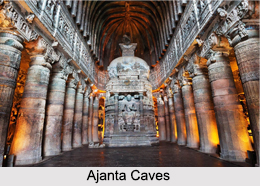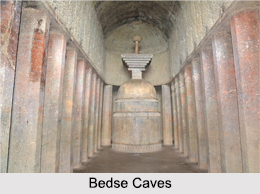 There are more than 1,500 known rock cut structures in India, out of which about 1000 were made by Buddhists, 300 by Hindus and 200 by Jains. Many of these structures contain works of art of global importance, and many later caves from the Mahayana period are adorned with exquisite stone carvings. These ancient and medieval structures represent significant achievements of structural engineering and craftsmanship.
There are more than 1,500 known rock cut structures in India, out of which about 1000 were made by Buddhists, 300 by Hindus and 200 by Jains. Many of these structures contain works of art of global importance, and many later caves from the Mahayana period are adorned with exquisite stone carvings. These ancient and medieval structures represent significant achievements of structural engineering and craftsmanship.
History of Buddhist Cave Temples
Buddhist Cave Temples in India are rampant and bear the bygone flavours of Buddhism. The earliest Buddhist Cave Temples belong to the period of Ashoka, who is said to be the founder of Viharas or monasteries, stupas or dagobas, asylums and other religious charitable works. The cave temples belonging to the age of Ashoka are mostly situated in Nagarjuni and Barabar Hills in Bihar. Of these chambers, four are on the Barabar hill and three on the Nagarjuni hill.
Buddhist Cave Temples have been classified into two distinct groups, as these belong to two great dimension of the Buddhist faith. To the first group belong those cave temples, which were excavated, so far as can be judged from style and inscriptions before the Christian era or during the first century. These belong to the Hinayana sect, or "lesser vehicle", or the original form of Buddhism. The cave temples of the second period belong to the Mahayana Buddhism, or the "Great Vehicle". The caves belonging to this sect are much less numerous.
Architecture of Buddhist Cave Temples
The ancient temple and intricate sculptures of Karla caves are mesmerizing. Karla and Bhaja rock-cut caves, sited near Lonavala in Maharashtra, are perfect examples of Buddhist cave Architecture in India. The history of these caves dated back to 2nd century BC. The beautiful interiors and the intricate sculptures of humans, Buddha and animals are fascinating. Moreover, these caves are remarkably well-adapted to Indian seasons as these are cozy in winter and cool in summer. The best feature of these caves is that they have a hemispherical `sun window` that sieves light towards Stupa or Dagoba sheltered by an engraved wooden umbrella.
 There is also a sculpture of Buddha seated on a lion-supported throne preaching his disciples. The sculpture also has splendid carvings of three elephants. Buddhist architecture consists of Rock cut caves, Viharas (Residential quarters for Monks), Stupas, Chaityas or Chaityagriha (assembly halls with a stupa), and Sangharamas (Buddhist monastery and school) etc.
There is also a sculpture of Buddha seated on a lion-supported throne preaching his disciples. The sculpture also has splendid carvings of three elephants. Buddhist architecture consists of Rock cut caves, Viharas (Residential quarters for Monks), Stupas, Chaityas or Chaityagriha (assembly halls with a stupa), and Sangharamas (Buddhist monastery and school) etc.
Famous Buddhist Cave Temples
The earliest caves employed by humans were natural caves used by local inhabitants for a variety of purposes, such as shrines and shelters. Evidence suggests that the caves were first occupied and slightly altered during the Palaeolithic and Mesolithic periods, up to about 6000 BC.
Ajanta Caves: The Ajanta Caves are approximately 30 rock-cut Buddhist cave monuments which date from the 2nd century BCE to about 480 CE in Aurangabad district of Maharashtra. The caves include paintings and rock-cut sculptures described as among the finest surviving examples of ancient Indian art, particularly expressive paintings that present emotions through gesture, pose and form.
The caves were built in two phases, the first starting around the 2nd century BCE and the second occurring from 400–650 CE, according to older accounts, or in a brief period of 460–480 CE according to later scholarship. The Ajanta Caves constitute ancient monasteries and worship-halls of different Buddhist traditions carved into a 75-meter wall of rock. The caves also present paintings depicting the past lives and rebirths of Buddha, pictorial tales from Aryasura`s Jatakamala, and rock-cut sculptures of Buddhist deities. While vivid colours and mural wall-painting, Caves 16, 17, 1 and 2 of Ajanta form the largest corpus of surviving ancient Indian wall-painting.
Barabar Hill Caves : The Barabar Hill Caves are the oldest surviving rock-cut caves in India, dating from the Maurya Empire, some with Ashokan inscriptions, located in the Makhdumpur region of Jehanabad district in Bihar near Gaya. These rock-cut chambers bear dedicatory inscriptions in the name of "King Piyadasi" for the Barabar group, and "Devanampiya Dasaratha" for the Nagarjuni group, thought to date back to the 3rd century BCE during the Maurya period, and to correspond respectively to Ashoka and his grandson, Dasharatha Maurya.
The sculptured entrance to the Lomas Rishi Cave is the earliest survival of the ogee shaped "chaitra arch" or chandrashala that was an important feature of Indian rock-cut architecture. The form was clearly a reproduction in stone of buildings in wood and other plant materials.
 Lomas Rishi Cave: The Lomas Rishi Cave, also called the Grotto of Lomas Rishi, is one of the man-made Barabar Caves in the Barabar and Nagarjuni hills of Jehanabad district in Bihar. This rock-cut cave was carved out as a sanctuary. It was built during the Ashokan period of the Maurya Empire in the 3rd century BC, as part of the sacred architecture of the Ajivikas, an ancient religious and philosophical group of India that competed with Jainism and became extinct over time. Still, the Lomas Rishi cave lacks an explicit epigraphical dedication to the Ajivikas, contrary to most other Barabar Caves.
Lomas Rishi Cave: The Lomas Rishi Cave, also called the Grotto of Lomas Rishi, is one of the man-made Barabar Caves in the Barabar and Nagarjuni hills of Jehanabad district in Bihar. This rock-cut cave was carved out as a sanctuary. It was built during the Ashokan period of the Maurya Empire in the 3rd century BC, as part of the sacred architecture of the Ajivikas, an ancient religious and philosophical group of India that competed with Jainism and became extinct over time. Still, the Lomas Rishi cave lacks an explicit epigraphical dedication to the Ajivikas, contrary to most other Barabar Caves.
Bhaja Caves: Bhaja Caves is a group of 22 rock-cut caves dating back to the 2nd century BC located in the city of Pune, India. The caves are 400 feet above the village of Bhaja, on an important ancient trade route running from the Arabian Sea eastward into the Deccan Plateau. The inscriptions and the cave temple are protected as a Monument of National Importance, by the Archaeological Survey of India. It belongs to the Hinayana Buddhism sect in Maharashtra. The caves have a number of stupas.
Karla Caves: Karla Caves are a complex of ancient Buddhist Indian rock-cut caves at Karli near Lonavala, Maharashtra. It is just 10.9 Kilometers away from Lonavala. Other caves in the area are Bhaja Caves, Patan Buddhist Cave, Bedse Caves and Nasik Caves. The shrines were developed over the period – from the 2nd century BCE to the 5th century CE.
Bedse Caves: Bedsa Caves are a group of Buddhist rock-cut monuments situated in Maval taluka, Pune District, Maharashtra. The history of the caves can be traced back to the Satavahana period in the 1st century BCE. Other caves in the area are Karla Caves, Patan Buddhist Cave and Nasik Caves. The best known cave is the chaitya (prayer hall - Cave 7) with a comparatively large stupa, the other cave is the monastery or vihara (Cave 11). They are marked by a profusion of decorative gavaksha or chaitya arch motifs.
 Kanheri Caves: Kanheri Caves are a group of caves and rock-cut monuments cut into a massive basalt outcrop in the forests of the Sanjay Gandhi National Park, on the former island of Salsette in the western outskirts of Mumbai. They contain Buddhist sculptures and relief carvings, paintings and inscriptions, dating from the 1st century CE to the 10th century CE. Kanheri comes from the Sanskrit Krishnagiri, which means Black Mountain.
Kanheri Caves: Kanheri Caves are a group of caves and rock-cut monuments cut into a massive basalt outcrop in the forests of the Sanjay Gandhi National Park, on the former island of Salsette in the western outskirts of Mumbai. They contain Buddhist sculptures and relief carvings, paintings and inscriptions, dating from the 1st century CE to the 10th century CE. Kanheri comes from the Sanskrit Krishnagiri, which means Black Mountain.
Ellora Caves: It is one of the largest rock-cut monastery-temple cave complexes in the world, featuring Hindu, Buddhist and Jain monuments, and artwork, dating from the 600–1000 CE period. Cave 16, in particular, features the largest single monolithic rock excavation in the world, the Kailash temple, a chariot shaped monument dedicated to Lord Shiva. The Kailash temple excavation also features sculptures depicting the gods, goddesses and mythologies found in Vaishnavism, Shaktism as well as relief panels summarizing the two major Hindu Epics.
As mercantile and royal endowments grew, cave interiors became more elaborate, with interior walls decorated in paintings, reliefs, and intricate carvings. Numerous donors provided the funds for the building of these caves and left donatory inscriptions, including laity, members of the clergy, government, and even foreigners such as Yavanas (Greeks) representing about 8% of all inscriptions.





















